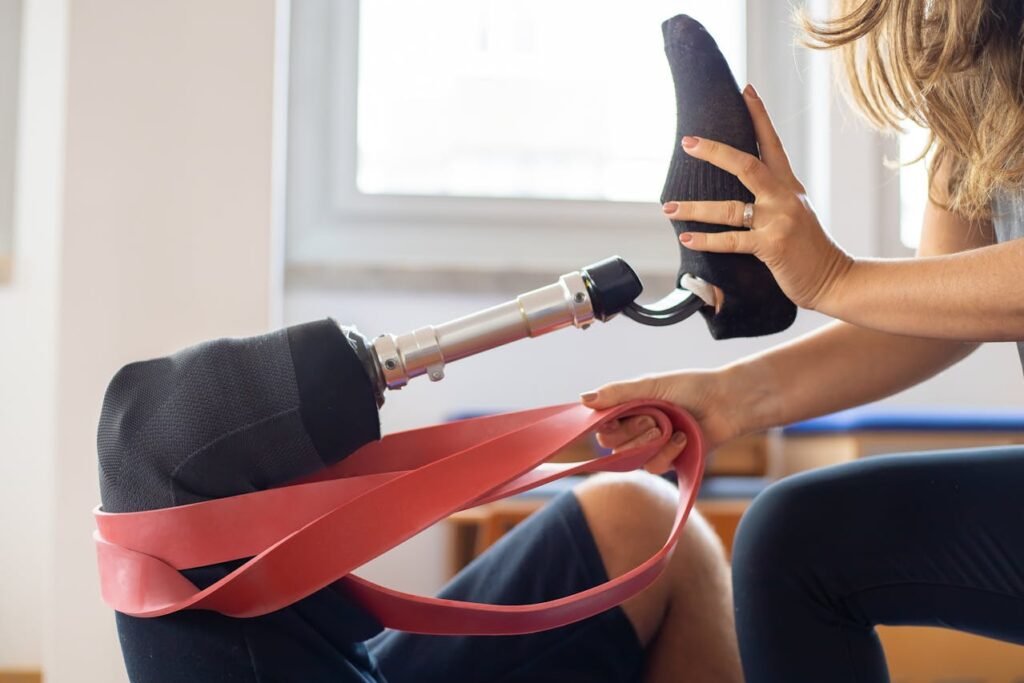After a leg amputation, getting a prosthetic is a big step forward—but it’s only part of the journey. To walk confidently and move freely again, physical therapy plays an essential role. Whether you’re a below-knee (transtibial) or above-knee (transfemoral) prosthetic user, physical therapy helps rebuild strength, balance, and trust in your body. It also prepares you for real-life movement, from walking indoors to navigating busy streets.
At Robobionics, we’ve worked with hundreds of prosthetic users across India. We’ve seen how guided physical therapy turns small, shaky steps into confident strides. In this beginner’s guide, we’ll walk you through the basics of physical therapy for both transtibial and transfemoral users, explain how each level of amputation affects recovery, and show you how the right approach can make every step smoother.
Starting Therapy After Amputation
Physical therapy usually starts soon after surgery. At first, the goal is not walking but healing and preparing the body for prosthetic use. These early steps are just as important as later movement training.
Preparing the Residual Limb
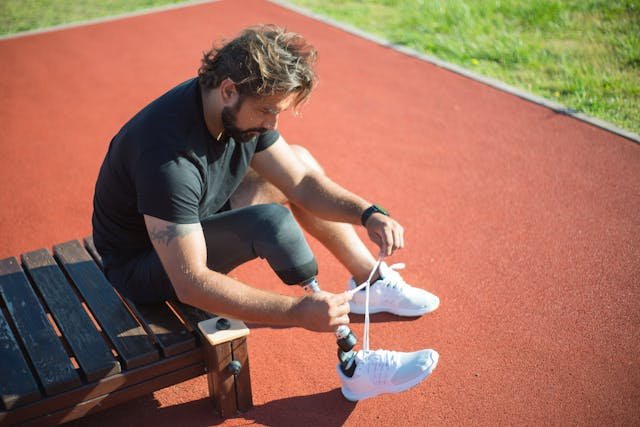
Before using a prosthetic, your residual limb must heal well and become strong. In these early weeks, therapists focus on reducing swelling, shaping the limb, and improving circulation. This helps the socket fit better later and reduces the risk of discomfort or skin issues.
For transtibial users, the residual limb is shorter, and the knee joint remains. Therapy here includes mild stretching, light muscle movements, and simple exercises to keep the leg active. For transfemoral users, the therapy focuses on the thigh and hip area, where more muscles need to adjust to the new limb length and motion patterns.
The goal is to help the limb become firm, healthy, and ready to support the prosthetic. At Robobionics, we often start working with patients even before the final prosthetic is fitted, ensuring a smooth transition into active use.
Managing Pain and Building Comfort
Pain, stiffness, and phantom sensations are common in the early days. Physical therapy helps reduce these issues through massage, gentle stretches, and guided positioning. Therapists also teach you how to lie, sit, and sleep in ways that support healing.
For transtibial users, managing knee movement is key to preventing joint stiffness. For transfemoral users, keeping the hip flexible and active becomes the focus. Learning these basics early helps prevent long-term discomfort and speeds up the later stages of therapy.
Robobionics works with experienced therapists who understand the unique needs of both levels of amputation. Our goal is to reduce pain, protect your body, and help you feel ready for the next phase.
Setting the Right Expectations
One of the most important parts of early physical therapy is understanding what to expect. Many people feel frustrated when they can’t walk right away. But recovery takes time. Your therapist will help you set small, reachable goals that build up over time.
Transtibial users often begin walking sooner, which can boost confidence early on. Transfemoral users may need more time, especially to learn how to control a prosthetic knee. That’s completely normal, and progress is always possible with the right plan and patience.
At Robobionics, we believe in encouraging every step, no matter how small. With the right mindset and a supportive team, every user can make steady progress at their own pace.
Balance and Core Strength: The Foundation of Movement
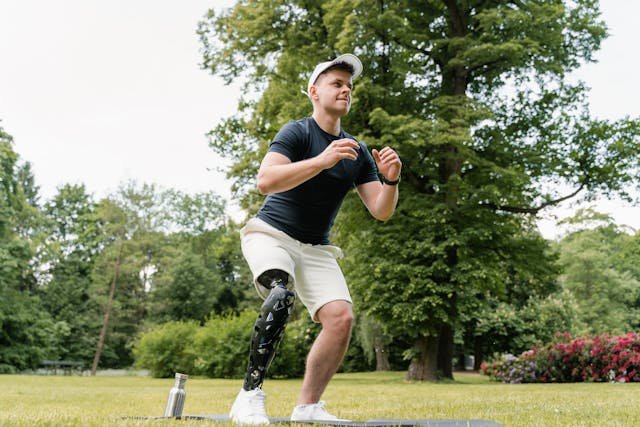
Before you walk confidently, you need to build balance and body control. This is where core strength becomes your best ally.
Why Balance Comes First
Walking with a prosthetic changes how your body holds weight. You need to relearn how to shift your body from one leg to the other. Without good balance, walking can feel shaky or tiring. That’s why therapists focus first on balance, even before walking.
Transtibial users usually regain balance faster because their knee helps support natural motion. They can rely on muscle memory and make quick adjustments. For transfemoral users, balancing takes more effort. The hip must take over much of the control, and the prosthetic knee adds more weight and movement.
Your therapist will guide you through exercises like standing evenly on both legs, shifting your weight, and keeping your posture straight. These early steps build a strong base for walking later.
Core Muscles and Posture Training
Your core is the center of your strength. It includes your stomach, back, and pelvic muscles. A strong core keeps your body stable and helps you stay upright during movement. Weak core muscles lead to slouching, imbalance, and extra pressure on your joints.
Transtibial users benefit from core training because it supports their remaining leg. Transfemoral users depend on their core even more, since their hips must control the prosthetic knee’s motion. Exercises like leg raises, bridge holds, and seated twists help build core strength gently but effectively.
Robobionics offers gamified rehab tools that make core exercises fun and easy to follow at home. These tools track your progress and help you stay motivated without getting bored.
Improving Awareness of Body Position
Good movement starts with awareness. This means knowing where your body is in space—whether you’re standing, reaching, or turning. This sense is often affected after amputation, but physical therapy helps rebuild it.
Therapists use balance boards, mirrors, and guided movements to help you reconnect with your body. You learn how your prosthetic moves, how to keep your weight even, and how to stand tall. These small changes in awareness make a big difference when you begin walking.
At Robobionics, we believe that physical therapy isn’t just about moving—it’s about feeling grounded in your body again. That’s when true confidence begins.
Walking Training with a Prosthetic Leg

Once your body is ready, it’s time to learn how to walk again. This is where physical therapy becomes more active, practical, and focused on real-life movement.
Starting with Parallel Bars and Support
Your first steps will likely happen between two parallel bars or with a walker. These tools provide support while you learn how to move safely. The therapist will help you step forward, place your foot correctly, and shift your weight with control.
Transtibial users often learn to walk with a natural gait pattern quickly. Their knee helps them bend and guide the leg smoothly. Transfemoral users must learn to control the prosthetic knee. They practice locking and unlocking it at the right times, and using their hips to guide each step.
Robobionics supports this stage with safe demo sessions and close therapist supervision. We encourage repetition and feedback to build muscle memory and reduce the fear of falling.
Building a Natural Gait
Walking naturally means more than just moving forward. It involves timing, stride length, and posture. A proper gait helps you walk longer without pain and prevents stress on your back and joints.
Transtibial users practice rolling from heel to toe, keeping their steps even, and matching both sides of their body. Transfemoral users work on knee control, hip motion, and using the right amount of pressure with each step. Both groups benefit from slow, focused practice.
Therapists may use tools like treadmills, step counters, and video analysis to fine-tune your walk. Robobionics also uses feedback-based training systems to help users see their progress clearly and improve faster.
Walking in Real Environments
The final part of walking therapy involves real-world conditions. You practice walking on different surfaces—tile, grass, gravel, and ramps. You also learn how to turn, stop, climb stairs, and navigate around obstacles.
Transtibial users may move through this stage quickly, but transfemoral users need more time and practice. The prosthetic knee reacts differently on slopes and uneven surfaces, so building trust and control is key.
At Robobionics, we encourage users to walk in safe outdoor environments during therapy, so they feel prepared for real-life situations. Our goal is to help you walk not just inside, but everywhere life takes you.
Strength Training for Long-Term Stability
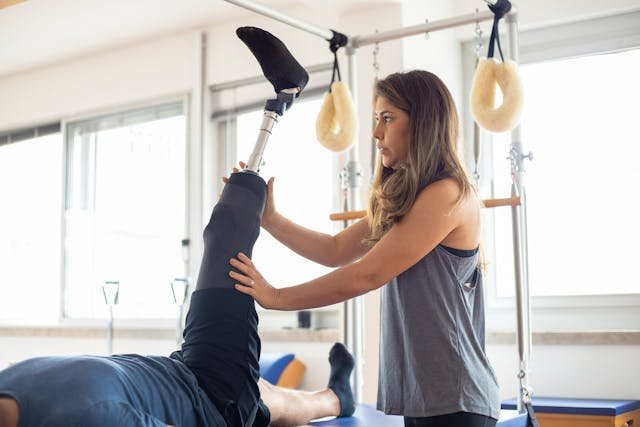
Once basic walking becomes comfortable, therapy shifts toward building strength that lasts. Strong muscles not only support movement but also protect joints, improve balance, and reduce the risk of falls or injury. For both transtibial and transfemoral users, this part of therapy builds endurance for daily life.
Targeting Key Muscle Groups
Every prosthetic user needs strong legs, hips, and core. These areas carry your weight, support your steps, and help you move smoothly. For below-knee users, focus is often placed on the thigh muscles and the remaining part of the leg. Strength in these muscles helps with smoother foot motion and better control of the prosthetic.
Above-knee users rely more on the upper thigh and hip muscles. Since they no longer have a natural knee, their hip takes over the job of guiding the leg forward. Exercises that build glute strength, hip flexors, and inner thigh muscles are essential for safe, energy-efficient walking.
At Robobionics, we work closely with each user’s therapy team to ensure exercises are matched to their stage of recovery. A personalized plan leads to better outcomes and builds strength without strain.
Building Endurance Through Repetition
Walking short distances is just the beginning. To get back to real life, users need to be able to move for longer periods—whether it’s walking through a market, going to work, or climbing stairs. Endurance exercises help your body get used to longer activity without fatigue.
This part of therapy includes slow, repeated movements such as stepping, seated leg lifts, standing up from a chair, or walking in loops. Over time, these simple exercises condition your body and reduce the tiredness that many users feel in the early weeks of prosthetic use.
Transtibial users often reach this level sooner, but transfemoral users benefit even more from endurance building, especially as they manage a heavier prosthetic system. With patience, every user sees noticeable improvements in stamina and comfort.
Progress Tracking and Small Wins
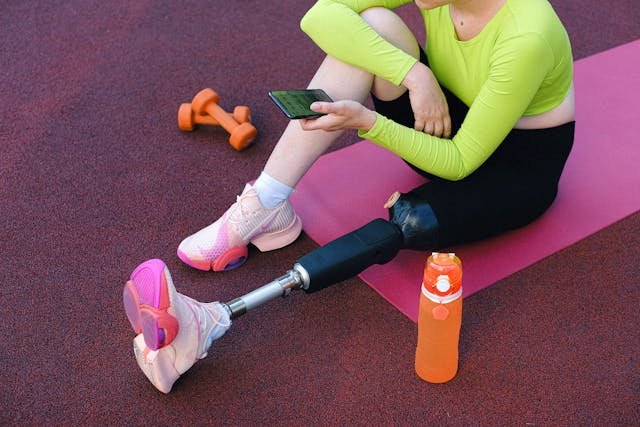
One of the most powerful motivators during therapy is seeing your own progress. Keeping track of how long you can walk, how much weight you can lift, or how stable you feel while standing gives you proof that your efforts are working. Even small wins—like walking five extra minutes or standing with better posture—are signs of growth.
At Robobionics, we use progress charts and digital rehab tools that help users visualize their improvement. This not only keeps them motivated but also helps therapists adjust the training as needed. Strength isn’t built in a day—but step by step, it transforms your life.
Flexibility, Mobility, and Daily Movement
Being able to move freely and comfortably in everyday life is just as important as walking. That’s why therapy also focuses on flexibility, joint health, and functional movement for both below-knee and above-knee prosthetic users.
Stretching to Avoid Stiffness
After amputation, many people experience stiffness in the joints near the residual limb. This can limit movement, cause discomfort, and interfere with prosthetic use. Regular stretching keeps the muscles and joints loose, flexible, and ready for activity.
Transtibial users need to stretch the knee and ankle areas, even if the foot is missing. Keeping the knee from becoming tight ensures better alignment with the prosthetic. Transfemoral users need to focus on hip flexibility, which helps with sitting, walking, and standing transitions.
Therapists guide users through gentle stretches tailored to their body and amputation level. Robobionics encourages users to make stretching part of their daily routine—even after formal therapy ends.
Improving Joint Mobility for Real-Life Tasks
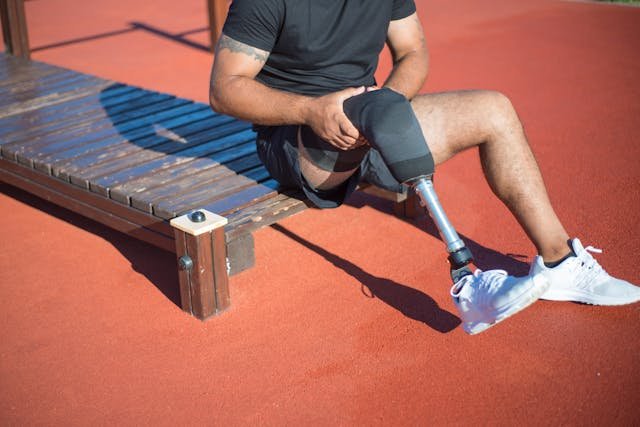
Daily tasks like sitting down, reaching for items, or getting into a car require more than just strong legs. They require mobile joints that move freely and without pain. For prosthetic users, practicing these movements helps make daily life smoother and more independent.
For transtibial users, mobility training helps with bending and stepping. For transfemoral users, it focuses on using the prosthetic knee efficiently while sitting or moving from one position to another. These tasks become easier when joints are trained to move in natural patterns.
At Robobionics, we encourage movement practice based on your lifestyle. If you work in an office, we’ll guide you through sitting and standing techniques. If you travel often, we’ll practice getting in and out of vehicles or navigating crowded spaces.
Regaining Movement Confidence
Feeling confident in movement is just as important as the movement itself. When users know they can bend, stretch, or move safely, they stop holding back. This confidence leads to better posture, smoother walking, and a more active life overall.
Transtibial users may feel confident earlier due to quicker adaptation, but transfemoral users often gain deeper emotional strength as they overcome greater physical challenges. Both journeys are valid and lead to lasting confidence through consistency and trust in the process.
Robobionics believes in celebrating movement—whether it’s your first stair climb or the ability to walk through your neighborhood. These are milestones of freedom, and they matter.
Conclusion
Physical therapy is the foundation of success for anyone using a below-knee or above-knee prosthetic. It builds strength, balance, coordination, and most importantly, confidence. While the therapy approach may differ between transtibial and transfemoral users, the goal is always the same: to help every user walk better, move easier, and live more freely.
Transtibial users may experience faster adaptation and fewer complications early on, but transfemoral users gain resilience and strength through their longer path. With a proper therapy plan, expert support, and a willingness to keep going, every user can make progress—no matter where they start.



